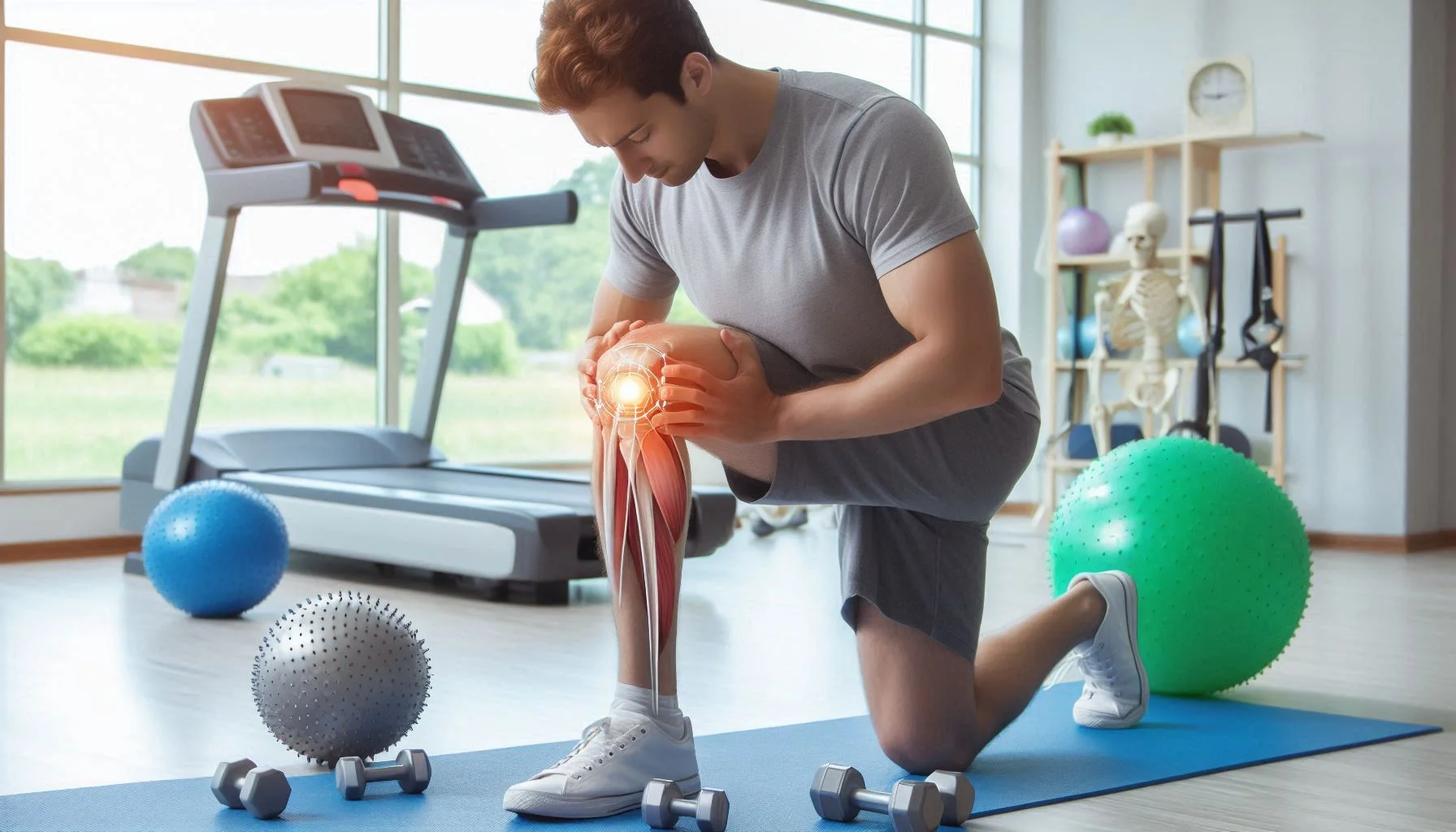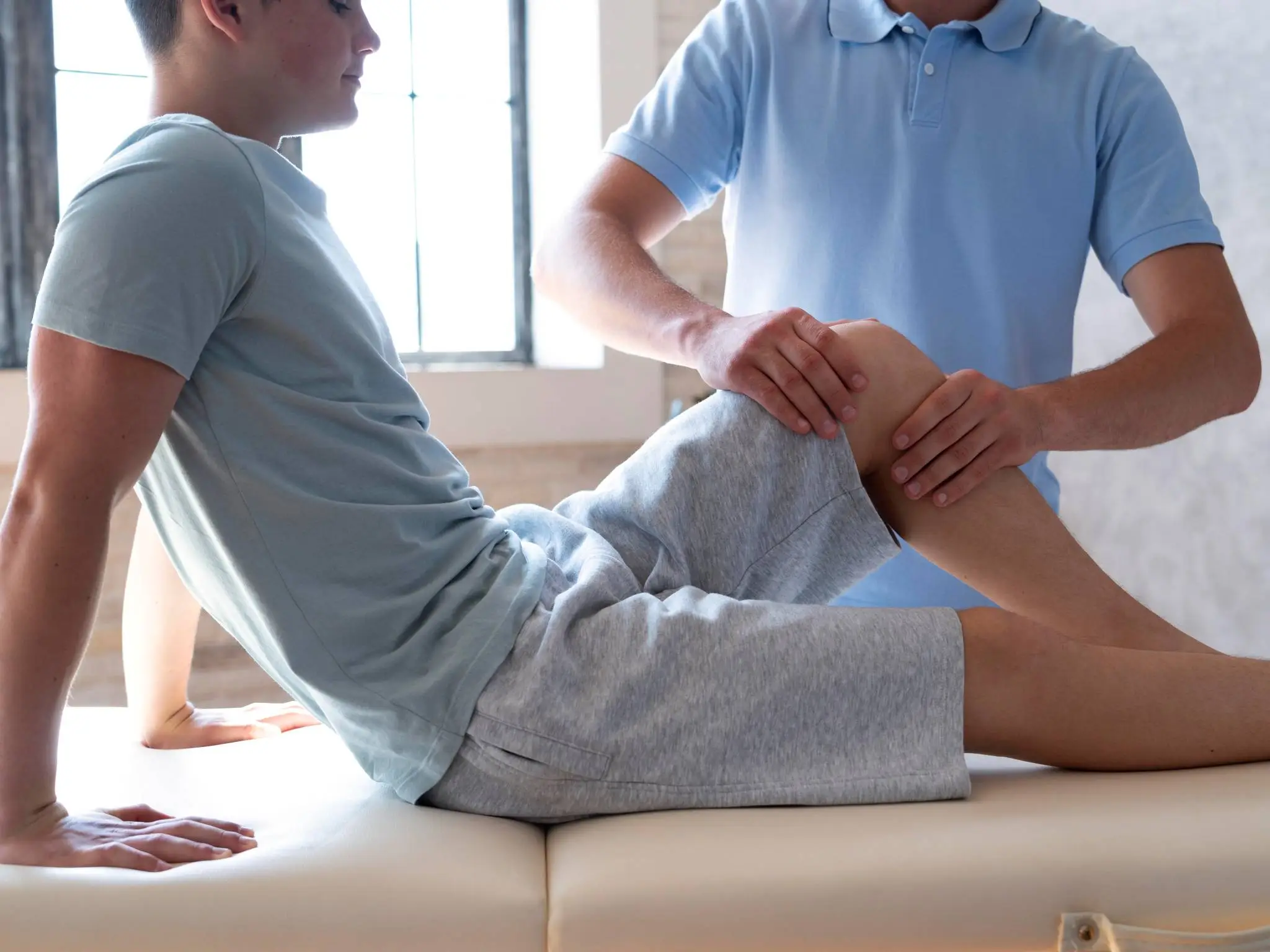Knee replacement surgery changes how you move. Recovery requires it to get strength and motion back. It’s not only about getting you back on your feet, but about doing it in a safe and proper way. Trust me, your knee will thank you! Whether you’re walking around Toronto or just want to take a stroll in your backyard, you’ll be looking to move freely. We’ll get into exercises and strategies for how to manage swelling. You’ll be more energized and feel stronger. Don’t worry, you’re not alone. Every step you take is one step closer to full recovery. Let’s make your knee journey a success!
Understanding Knee Rehab Phases
What Are Rehab Exercises?
OK, it’s time to get into the rehab exercises. After knee replacement, you get back on your feet by doing the right exercises. These are your secret weapon to getting your strength, flexibility, and confidence back. At Focus Physiotherapy, we’re here to provide you with exercises that specifically suit your needs. We’re referring to a combination of stretching, strengthening, and balance exercises that allow you to move freely and without pain. Imagine exercises like:
-
You lie on your back and slowly slide your heel towards your butt, bending your knee. This one will be good for flexibility in your knees.
-
You tighten your thigh muscles (quads) while keeping your leg straight. This helps to strengthen the muscles that support your knee.
-
Lying down, you lift your leg with your knee straight. It’s really just about building up that leg muscle.
We’ve become ninjas at safe, effective exercises. Our registered physiotherapists are always watching closely to ensure your well-being.
Why Rehab is Essential?
Rehab isn’t an option — it’s a must. Post-surgery, your knee needs a game plan to get back to doing what it does best. Why? Well, rehab:
-
It’s like hitting the fast-forward button on your healing process. You’ll notice improved movement and less pain much quicker.
-
Think of it as giving your knee muscles a much-needed workout, making them strong enough to support your new joint.
-
Rehab exercises keep you moving, reducing the risk of blood clots and stiffness—common post-surgery pitfalls.
-
As you progress, you’ll feel more confident in your knee’s ability, which is crucial for returning to daily activities.
At our clinic, we look at your physical health. We also offer emotional support, giving you strength one step at a time.
Overview of Recovery Phases
Recovery isn’t a one-size-fits-all deal. It’s a journey that takes place in phases, each with its own objectives and emphasis. Here’s a peek into what these phases look like:
-
Early Recovery (0-2 weeks): Because right after surgery, it’s all about gentle movements. We begin with basic exercises to help circulation and decrease swelling. During this phase, you might use a walker.
-
Mid Recovery (2-6 weeks): This is when things start to pick up. We add more difficult exercises to develop strength, and we add more range of motion. You’ll likely be walking without aids by the conclusion of this phase.
-
Instead, at this point, you’ll focus on getting back to normal activities. Exercises get more advanced, personalized to your lifestyle—be it returning to sports or just walking the dog.
We’re here to support you through each stage. We’ll help keep you on track and revise your plan if we need to. Rehab is a team effort, and together we’ll get you back to living life to the fullest.
Initial Recovery Phase
1. Begin with Ankle Pumps
Okay, let’s start with ankle pumps. They may sound basic, but these small movements are anything but small when it comes to the advantages. Ankle pumps are where you want to start when you’re recovering from ankle surgery. They aid blood flow and decrease swelling, which is also extremely important post-knee surgery. Lie on your back and lift your feet. Move them up and down, as if you’re pressing on a gas pedal. This one keeps your circulation going, so the risk of clots is lowered.
Ankle pumps are important. They get your body moving early, and that’s key. Early mobility is a game-changer when it comes to recovery. Plus, they’re easy to do in bed, so no excuses here. You can even do them while waiting for your ice therapy, which helps with swelling and pain.
2. Perform Quadriceps Sets
Next up are the quadriceps sets, which focus on reactivating those thigh muscles. Most folks going into knee surgery have weak quads, so these exercises are a must. To do them, simply tighten your thigh muscles, hold for a few seconds, and then relax. It’s the way of giving your quads a little wake-up call.
What makes quadriceps sets so important? First, they’re easy and can be performed without getting out of bed. Second, they help keep muscle tone and start to rebuild strength. The quads are important for knee stability; they need to be my first order of business getting back in shape. Remember, it’s not just about getting the movement back; it’s about building that strength too.
3. Practice Straight Leg Raises
Now let’s get into straight leg raises. This exercise is also great for working your quads and your core. Lie on your back, keep one leg straight, and lift it up slowly. Sounds simple, yet it kicks your muscles where they need it.
Why bother with straight leg raises? They promote knee extension, which is important for walking correctly. The target is to achieve full knee extension within the first 48 hours after surgery. This exercise plays a large part in that. It builds confidence as you notice your leg getting stronger and more mobile.
4. Execute Knee Straightening Movements
All knee straightening movements are about increasing your range of motion. You’re trying to get that knee as straight as it can be, which is applicable to everyday life. Sit comfortably and use your thigh muscles to push your knee down into a straight position. You may feel a bit of a stretch, and that’s a good thing.
Why focus on knee straightening? For the simple reason that it creates the basis for all other movements. Having full knee extension early on makes everything else easier, from walking to climbing stairs. Remember, the hardest part can be regaining motion, so these exercises are critical.
5. Practice Bed-Based Knee Bends
Knee bends while on the bed. This one’s about working on knee flexion. Lie on your back and slowly bend your knee, bringing your foot towards your butt. It’s like nudging your knee to get it to start bending again.
What’s the purpose of knee bends? You want to get more flexion of the knee, according to your surgeon’s recommendations. This exercise may be hard right now. It’s a vital part of reducing stiffness and improving your range of motion. It’s a nice way to gauge progress when your knee grows more flexible over time.
6. Attempt Supported Sitting Bends
Supported sitting bends are a little more difficult. Sit on a chair with your feet flat on the floor. Use your hands or a towel underneath the foot to help slide your foot back, bending the knee. These are great for increasing knee mobility and getting comfortable with bending.
Why bother with supported sitting bends? They transition you from bed-based exercises to more dynamic movements. They foster confidence and control, both of which are key when you’re getting back on your feet. Plus, they’re a great way to practice knee flexion safely.
7. Try Unsupported Sitting Bends
Finally, let’s deal with unsupported sitting bends. Once you feel more confident, you can try bending your knee without support. Sit on a chair, then let your knee bend naturally, using only your leg muscles.
Why go for unsupported sitting bends? Because they’re a huge leap towards independence. They strengthen your knee and enhance coordination, which is especially important for everyday activities. Best of all, they make you feel like you’ve accomplished something — you’re getting closer to recovery. You should be able to find these activities a breeze by 12 weeks following your surgery. You’ll be ready for low-impact workouts such as walking and swimming.

Early Physical Activity
Start Walking Gradually
Can you tell us a bit more about what you mean by that? If you’re coming back from knee replacement surgery, begin with some gentle walking. It’s a really good way to ease into your recovery process. Now, don’t go trying to run a marathon just yet. We’re into baby steps here, literally! Walking is one of the easiest exercises you can do to get back on your feet. It helps with circulation, reduces swelling, and keeps those joints nice and flexible.
Early postoperative physical activity does not adversely affect your TUG test score. You can feel confident about performance six months after total knee arthroplasty (TKA). That means starting to walk early won’t throw off your long-term progress. In fact, post-surgery, it’s being active that’s a big deal when it comes to improving your TUG scores. Keep it up two or three times a week till you’re at least around eight to ten months post-op. This routine keeps you on track with your recovery and builds muscle strength and physical function. You may plateau around six months, but that’s totally normal for most people.
Don’t sweat this counting every single step part. The average number of steps you take daily doesn’t really impact your TUG scores six months after surgery. Where the real magic occurs is when you go for less but better. It’s the activity you do on the second through the ninth day after your surgery that matters the most. It correlates with both pre- and postoperative physical function. So, pull on those comfy shoes and begin with brief, regular romps through your house or garden. Let’s make those early steps count!
Manage Stairs Carefully
Stairs can be a bit of a tricky beast after knee surgery. It’s like bending a dragon to your will, except you can do it. The key here is to take it slow and steady. When you’re ready to tackle the stairs, make sure you’re using a handrail for support. Step up with your good leg first, and bring your operated leg up second; then reverse the order coming down. It’s a simple trick, but it makes things so much more manageable.
Early physical activity, such as learning stairs, enhances your overall recovery. Plus, it won’t affect your TUG scores at six months. Remember, you’re a warrior on a journey, and every careful step forward is a victory. Those stairs aren’t just stairs; they’re your path back to independence. It’s not just about going up and down. It’s about feeling more in control and getting back to your routine.
Let’s break it down: Use the railing, take it one step at a time, and don’t rush. Practice this a few times a week, and you’ll notice that it becomes easier. It’s all part of the healing process, and soon enough, stairs won’t feel like an obstacle anymore. They’ll be part of your regular walk in the park—literally.
Advanced Rehabilitation Techniques
Engage in Standing Knee Bends
Okay, let’s talk about some standing knee bends here. This exercise is simple but incredibly effective. It enhances your knee’s range of motion and strength following surgery. It’s something that you can do very easily at home or even at the clinic. Here’s what you do: stand with your feet hip-width apart, then gently bend your knee as if you’re about to sit back in a chair. Hold this position for a few seconds, then stand back up. It’s not a ton about bending; it’s about feeling that stretch and really working on those muscles around your knee.
Why go through all the effort of doing this? The more you move, the faster you recover. Studies show that beginning gentle exercises soon after surgery can have a significant impact on your healing. Imagine being able to climb stairs with ease—95% of patients get there after recovery. Don’t be afraid of these turns. They’re your bridge to getting back in the swing of things.
Use Assisted Bending Methods
Sometimes, we all need a little help, and that’s where assisted bending methods come in. Picture this: you’re sitting comfortably with a towel or strap looped around your foot. Gently pull on the strap to bring your knee toward your chest. It’s a friendly way to give your knee’s flexibility a boost without overdoing it.
Assisted bending allows you to gradually increase your knee’s range of motion, and that’s important for your recovery. You start moving within hours of surgery, and these methods are a great way to keep that momentum going. Remember, it’s about progress, not perfection. With time, you’ll notice your knee getting stronger and more flexible. Stick with it, and you’ll thank yourself later.
Incorporate Resistance Training
Let’s talk resistance training. Sounds intense, but I promise, it’s your knee’s best friend in rehab. Resistance bands or light weights can work wonders building strength in your knee and surrounding muscles. It’s like giving your knee a little nudge to be stronger.
How do you do this? Begin with gentle exercises such as leg lifts or seated knee extensions with a resistance band. Do this for 20–30 minutes a day, and you’ll get better at it. Long-term maintenance is the magic word here, my friends. Even after you’ve fully recovered, incorporate these exercises into your routine to keep your knee strong and healthy.
Include Stationary Cycling
Now, who doesn’t enjoy a sweet session of a different kind of cycle? Stationary cycling is a great low-impact option that will get your knee moving smoothly. You can even begin cycling on a stationary bike as soon as two weeks after surgery. It’s about pacing yourself and letting your range of motion increase gradually.
Cycling is a very gentle way to lubricate your knee joints and work on your overall mobility. Once you feel comfortable, aim for a 30-minute session every day. Trust me, it’s more than about recovery; it’s about keeping your fitness as well. It also just feels amazing to be back in the saddle.

Managing Pain and Swelling
Apply Ice Packs Effectively
Okay, let’s talk ice packs. They’re like your best buddy right after knee surgery. When you wake up from surgery, you’ll feel pretty good. Those meds will still be doing their thing for you! When they start to wear off, you’ll need something to help with the pain and swelling. Enter ice packs!
Long-Term Recovery Strategies
Enhance Range of Motion
Getting that knee moving again is a big deal. The more you focus on improving your range of motion, the better your knee will feel. In the long run, this effort pays off in a big way. You do want to keep doing those prescribed exercises, even when that initial pain is gone. Think of it like brushing your teeth—small effort but huge payoff. You should be aiming for 10 to 15 minutes of activity twice a day. It’s also important to gradually increase how long your sessions are—building up to 20 to 30 minutes several times a week. Stick with it, and you’ll find less stiffness and more ease in your movements.
Now, let’s talk about how long this roller-coaster ride can go on for. Recovery is a marathon, not a sprint. You may need 4 to 6 months — and up to a year — to return to the full function of your knee. Be patient; your knee will feel like its old self again! Don’t panic! Twelve weeks after surgery, you can start engaging in low-impact activities such as walking and swimming. Stick with these, and you won’t just recover; you’ll be better than ever.
Strengthen Quadriceps Muscles
Alright, let’s fire those quads up! These are the muscles right above your knee, and they’re super important for keeping your knee stable. Strengthening them means you’ll be on firmer ground—literally. Your physical therapist will likely prescribe exercises specifically for these muscles. Do these things every day. 20-30 minutes a day; 2 to 3 sessions you can push if you’re game!
Why target the quads, you may wonder. Those muscles allow you to stand up, walk, and climb stairs painlessly and without wobbling. Stay strong, and you will be back at life before you know it. You may even find the courage to test out some new ones you’ve been wanting to try! Consistency is obviously a big thing here, and it’s something your orthopaedic surgeon will tell you. Trust me, your future self will thank you.
Maintain Cardiovascular Health
Keeping your heart healthy is just as important as fixing that knee. You’ll also want to incorporate exercises that improve your heart health into your routine. When you do, you’re caring not just for your knee, but your whole body. Start with walking 30 minutes, 2 to 3 times a week. It’s a simple way to keep your heart pumping and your spirits high.
As you continue, notice how you feel more energized and happier. You’re encouraged to continue, because you’re repairing yourself and becoming stronger. These exercises actually complement your knee rehab beautifully, creating a true holistic approach to recovery. By 12 weeks, most folks find they can enjoy more activity with much less pain and more joy.


